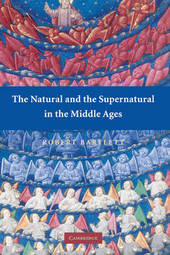
|
The Natural and the Supernatural in the Middle Ages
Hardback
Main Details
| Title |
The Natural and the Supernatural in the Middle Ages
|
| Authors and Contributors |
By (author) Robert Bartlett
|
| Series | The Wiles Lectures |
|---|
| Physical Properties |
| Format:Hardback | | Pages:182 | | Dimensions(mm): Height 229,Width 152 |
|
| Category/Genre | World history - c 500 to C 1500 |
|---|
| ISBN/Barcode |
9780521878326
|
| Classifications | Dewey:130.902 |
|---|
| Audience | | Professional & Vocational | | Tertiary Education (US: College) | |
|---|
| Illustrations |
13 Halftones, unspecified
|
|
Publishing Details |
| Publisher |
Cambridge University Press
|
| Imprint |
Cambridge University Press
|
| Publication Date |
17 March 2008 |
| Publication Country |
United Kingdom
|
Description
How did people of the medieval period explain physical phenomena, such as eclipses or the distribution of land and water on the globe? What creatures did they think they might encounter: angels, devils, witches, dogheaded people? This fascinating book explores the ways in which medieval people categorized the world, concentrating on the division between the natural and the supernatural and showing how the idea of the supernatural came to be invented in the Middle Ages. Robert Bartlett examines how theologians and others sought to draw lines between the natural, the miraculous, the marvelous and the monstrous, and the many conceptual problems they encountered as they did so. The final chapter explores the extraordinary thought-world of Roger Bacon as a case study exemplifying these issues. By recovering the mentalities of medieval writers and thinkers the book raises the critical question of how we deal with beliefs we no longer share.
Author Biography
Robert Bartlett is Bishop Wardlaw Professor of Mediaeval History at the University of St Andrews. His previous publications include The Making of Europe (1993), England under the Norman and Angevin Kings (2000) and The Hanged Man (2004).
Reviews'... engaging, accessible and thought-provoking ... The book eloquently indicates the complexity of medieval ideas.' BBC History Magazine
|